[English] 日本語
 Yorodumi
Yorodumi- EMDB-20127: Bacillus halodurans Cas1-Cas2 complex in presence of target CRISPR DNA -
+ Open data
Open data
- Basic information
Basic information
| Entry | Database: EMDB / ID: EMD-20127 | |||||||||
|---|---|---|---|---|---|---|---|---|---|---|
| Title | Bacillus halodurans Cas1-Cas2 complex in presence of target CRISPR DNA | |||||||||
 Map data Map data | Bacillus halodurans Cas1-Cas2 complex in presence of target CRISPR DNA | |||||||||
 Sample Sample |
| |||||||||
| Biological species |  Bacillus halodurans C-125 (bacteria) Bacillus halodurans C-125 (bacteria) | |||||||||
| Method | single particle reconstruction / negative staining / Resolution: 22.1 Å | |||||||||
 Authors Authors | Sashital DG / Lee H / Dhingra Y | |||||||||
 Citation Citation |  Journal: Elife / Year: 2019 Journal: Elife / Year: 2019Title: The Cas4-Cas1-Cas2 complex mediates precise prespacer processing during CRISPR adaptation. Authors: Hayun Lee / Yukti Dhingra / Dipali G Sashital /  Abstract: CRISPR adaptation immunizes bacteria and archaea against viruses. During adaptation, the Cas1-Cas2 complex integrates fragments of invader DNA as spacers in the CRISPR array. Recently, an additional ...CRISPR adaptation immunizes bacteria and archaea against viruses. During adaptation, the Cas1-Cas2 complex integrates fragments of invader DNA as spacers in the CRISPR array. Recently, an additional protein Cas4 has been implicated in selection and processing of prespacer substrates for Cas1-Cas2, although this mechanism remains unclear. We show that Cas4 interacts directly with Cas1-Cas2 forming a Cas4-Cas1-Cas2 complex that captures and processes prespacers prior to integration. Structural analysis of the Cas4-Cas1-Cas2 complex reveals two copies of Cas4 that closely interact with the two integrase active sites of Cas1, suggesting a mechanism for substrate handoff following processing. We also find that the Cas4-Cas1-Cas2 complex processes single-stranded DNA provided in cis or in trans with a double-stranded DNA duplex. Cas4 cleaves precisely upstream of PAM sequences, ensuring the acquisition of functional spacers. Our results explain how Cas4 cleavage coordinates with Cas1-Cas2 integration and defines the exact cleavage sites and specificity of Cas4. | |||||||||
| History |
|
- Structure visualization
Structure visualization
| Movie |
 Movie viewer Movie viewer |
|---|---|
| Structure viewer | EM map:  SurfView SurfView Molmil Molmil Jmol/JSmol Jmol/JSmol |
| Supplemental images |
- Downloads & links
Downloads & links
-EMDB archive
| Map data |  emd_20127.map.gz emd_20127.map.gz | 1.7 MB |  EMDB map data format EMDB map data format | |
|---|---|---|---|---|
| Header (meta data) |  emd-20127-v30.xml emd-20127-v30.xml emd-20127.xml emd-20127.xml | 14.3 KB 14.3 KB | Display Display |  EMDB header EMDB header |
| Images |  emd_20127.png emd_20127.png | 38.9 KB | ||
| Archive directory |  http://ftp.pdbj.org/pub/emdb/structures/EMD-20127 http://ftp.pdbj.org/pub/emdb/structures/EMD-20127 ftp://ftp.pdbj.org/pub/emdb/structures/EMD-20127 ftp://ftp.pdbj.org/pub/emdb/structures/EMD-20127 | HTTPS FTP |
-Validation report
| Summary document |  emd_20127_validation.pdf.gz emd_20127_validation.pdf.gz | 77.6 KB | Display |  EMDB validaton report EMDB validaton report |
|---|---|---|---|---|
| Full document |  emd_20127_full_validation.pdf.gz emd_20127_full_validation.pdf.gz | 76.7 KB | Display | |
| Data in XML |  emd_20127_validation.xml.gz emd_20127_validation.xml.gz | 494 B | Display | |
| Arichive directory |  https://ftp.pdbj.org/pub/emdb/validation_reports/EMD-20127 https://ftp.pdbj.org/pub/emdb/validation_reports/EMD-20127 ftp://ftp.pdbj.org/pub/emdb/validation_reports/EMD-20127 ftp://ftp.pdbj.org/pub/emdb/validation_reports/EMD-20127 | HTTPS FTP |
-Related structure data
| Related structure data | C: citing same article ( |
|---|---|
| Similar structure data |
- Links
Links
| EMDB pages |  EMDB (EBI/PDBe) / EMDB (EBI/PDBe) /  EMDataResource EMDataResource |
|---|
- Map
Map
| File |  Download / File: emd_20127.map.gz / Format: CCP4 / Size: 2 MB / Type: IMAGE STORED AS FLOATING POINT NUMBER (4 BYTES) Download / File: emd_20127.map.gz / Format: CCP4 / Size: 2 MB / Type: IMAGE STORED AS FLOATING POINT NUMBER (4 BYTES) | ||||||||||||||||||||||||||||||||||||||||||||||||||||||||||||
|---|---|---|---|---|---|---|---|---|---|---|---|---|---|---|---|---|---|---|---|---|---|---|---|---|---|---|---|---|---|---|---|---|---|---|---|---|---|---|---|---|---|---|---|---|---|---|---|---|---|---|---|---|---|---|---|---|---|---|---|---|---|
| Annotation | Bacillus halodurans Cas1-Cas2 complex in presence of target CRISPR DNA | ||||||||||||||||||||||||||||||||||||||||||||||||||||||||||||
| Projections & slices | Image control
Images are generated by Spider. | ||||||||||||||||||||||||||||||||||||||||||||||||||||||||||||
| Voxel size | X=Y=Z: 3.8 Å | ||||||||||||||||||||||||||||||||||||||||||||||||||||||||||||
| Density |
| ||||||||||||||||||||||||||||||||||||||||||||||||||||||||||||
| Symmetry | Space group: 1 | ||||||||||||||||||||||||||||||||||||||||||||||||||||||||||||
| Details | EMDB XML:
CCP4 map header:
| ||||||||||||||||||||||||||||||||||||||||||||||||||||||||||||
-Supplemental data
- Sample components
Sample components
-Entire : Bacillus halodurans Cas1-Cas2 complex with target CRISPR hairpin DNA
| Entire | Name: Bacillus halodurans Cas1-Cas2 complex with target CRISPR hairpin DNA |
|---|---|
| Components |
|
-Supramolecule #1: Bacillus halodurans Cas1-Cas2 complex with target CRISPR hairpin DNA
| Supramolecule | Name: Bacillus halodurans Cas1-Cas2 complex with target CRISPR hairpin DNA type: organelle_or_cellular_component / ID: 1 / Parent: 0 / Macromolecule list: all |
|---|---|
| Source (natural) | Organism:  Bacillus halodurans C-125 (bacteria) Bacillus halodurans C-125 (bacteria) |
| Molecular weight | Experimental: 240 KDa |
-Macromolecule #1: Cas1
| Macromolecule | Name: Cas1 / type: protein_or_peptide / ID: 1 / Enantiomer: LEVO |
|---|---|
| Source (natural) | Organism:  Bacillus halodurans C-125 (bacteria) Bacillus halodurans C-125 (bacteria) |
| Recombinant expression | Organism:  |
| Sequence | String: MKKLLNTLYV TQPDTYLSLD GDNVVLLKEQ EKLGRLPLHN LEAIVGFGYT GASPALMGYC AERNISITFL TKNGRFLARV VGESRGNVVL RKTQYRISEN DQESTKIARN FITGKVYNSK WMLERMTREH PLRVNVEQFK ATSQLLSVMM QEIRNCDSLE SLRGWEGQAA ...String: MKKLLNTLYV TQPDTYLSLD GDNVVLLKEQ EKLGRLPLHN LEAIVGFGYT GASPALMGYC AERNISITFL TKNGRFLARV VGESRGNVVL RKTQYRISEN DQESTKIARN FITGKVYNSK WMLERMTREH PLRVNVEQFK ATSQLLSVMM QEIRNCDSLE SLRGWEGQAA INYNKVFDQM ILQQKEEFAF HGRSRRPPKD NVNAMLSFAY TLLANDVAAA LETVGLDAYV GFMHQDRPGR ASLALDLMEE LRGLYADRFV LSLINRKEMT ADGFYKKENG AVLMTDEARK TFLKAWQTKK QEKITHPYLG EKMSWGLVPY VQALLLARFL RGDLDEYPPF LWK |
-Macromolecule #2: Cas2
| Macromolecule | Name: Cas2 / type: protein_or_peptide / ID: 2 / Enantiomer: LEVO |
|---|---|
| Source (natural) | Organism:  Bacillus halodurans C-125 (bacteria) Bacillus halodurans C-125 (bacteria) |
| Recombinant expression | Organism:  |
| Sequence | String: MLVLITYDVQ TSSMGGTKRL RKVAKACQNY GQRVQNSVFE CIVDSTQLTS LKLELTSLID EEKDSLRIYR LGNNYKTKVE HIGAKPSIDL EDPLIF |
-Macromolecule #3: hairpin CRISPR target
| Macromolecule | Name: hairpin CRISPR target / type: dna / ID: 3 / Classification: DNA |
|---|---|
| Source (natural) | Organism:  Bacillus halodurans C-125 (bacteria) Bacillus halodurans C-125 (bacteria) |
| Sequence | String: GATTTTCGCT GTCGCACTCT TCATGGGTGC GTGGATTGAA ATATTGACGA TAGTCAATAT TTCAATCCAC GCACCCATGA AGAGTGCGAC AGCGAAAATC |
-Experimental details
-Structure determination
| Method | negative staining |
|---|---|
 Processing Processing | single particle reconstruction |
| Aggregation state | particle |
- Sample preparation
Sample preparation
| Concentration | 0.024 mg/mL | ||||||||||||||||||
|---|---|---|---|---|---|---|---|---|---|---|---|---|---|---|---|---|---|---|---|
| Buffer | pH: 7.5 Component:
| ||||||||||||||||||
| Staining | Type: NEGATIVE / Material: uranyl formate Details: 3 uL of sample was applied to a glow-discharged copper 400-mesh continuous carbon grid for one minute at room temperature. The excess sample was blotted with Whatman filter paper, followed ...Details: 3 uL of sample was applied to a glow-discharged copper 400-mesh continuous carbon grid for one minute at room temperature. The excess sample was blotted with Whatman filter paper, followed by immediate application of 3 uL 2% (w/v) uranyl formate. The excess stain was blotted, followed by immediate application of 3 uL 2% uranyl formate. This step was repeated once more. The grids were allowed to dry for at least 5 minutes prior to imaging. | ||||||||||||||||||
| Grid | Support film - Material: CARBON / Support film - topology: CONTINUOUS / Pretreatment - Type: GLOW DISCHARGE / Pretreatment - Atmosphere: AIR / Details: unspecified |
- Electron microscopy
Electron microscopy
| Microscope | JEOL 2100 |
|---|---|
| Image recording | Film or detector model: GATAN ULTRASCAN 4000 (4k x 4k) / Digitization - Dimensions - Width: 4096 pixel / Digitization - Dimensions - Height: 4096 pixel / Number grids imaged: 1 / Number real images: 200 / Average exposure time: 0.5 sec. / Average electron dose: 30.0 e/Å2 |
| Electron beam | Acceleration voltage: 200 kV / Electron source: LAB6 |
| Electron optics | Illumination mode: FLOOD BEAM / Imaging mode: BRIGHT FIELD |
 Movie
Movie Controller
Controller


 UCSF Chimera
UCSF Chimera




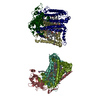
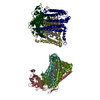
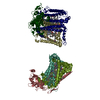
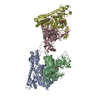
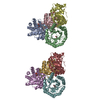


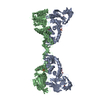
 Z (Sec.)
Z (Sec.) Y (Row.)
Y (Row.) X (Col.)
X (Col.)






















